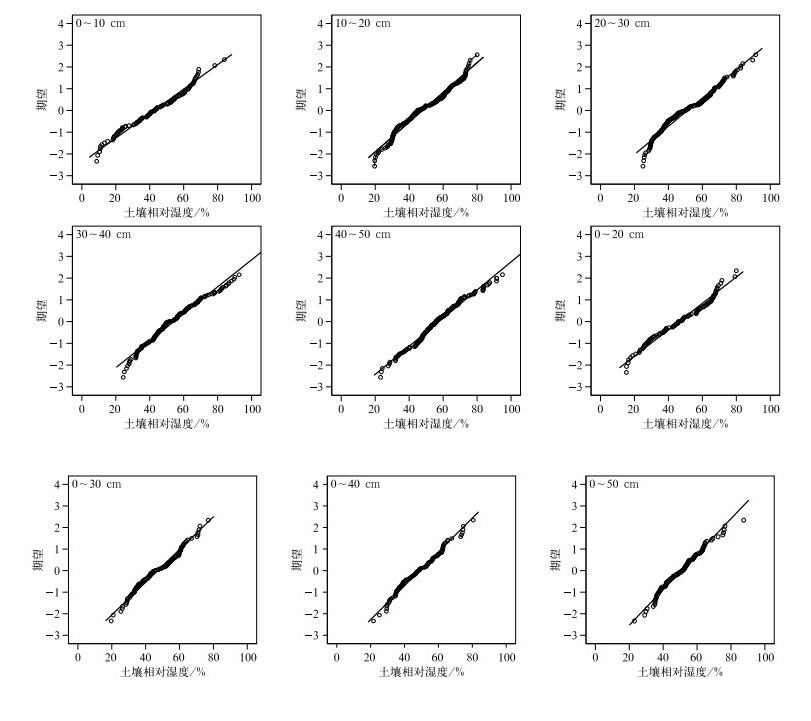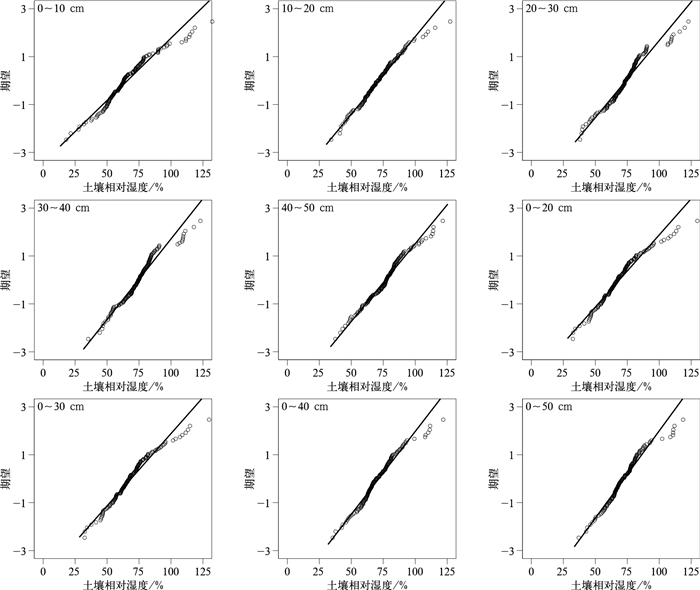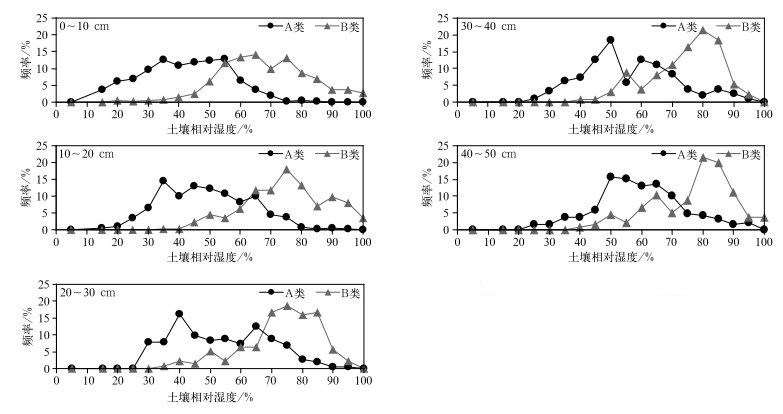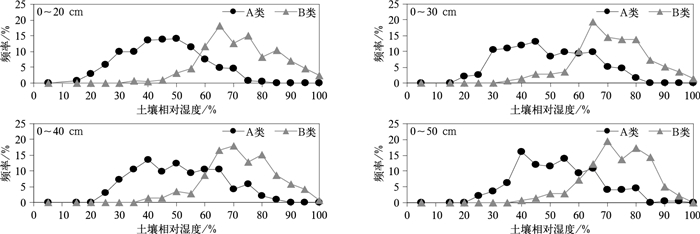The Influence of Soil Relative Moisture on Dry-hot Wind Disaster of Winter Wheat
-
摘要: 以华北黄淮地区高温低湿型冬小麦干热风灾害为研究对象,基于逐日逐时气象资料、分层土壤水分资料、灾情资料等,采用历史灾情反演、独立t检验等方法,将灾情记录中无明确记载和有明确记载土壤相对湿度影响干热风灾害的样本分为A类和B类,基于两类样本相互独立,厘定各土层对干热风灾害有影响的土壤相对湿度阈值,利用随机预留样本验证阈值的合理性。结果表明:分层和整层土壤相对湿度阈值均随土层深度增加而增大,其中整层阈值平均值近似60%;独立样本检验符合率在80%左右。为便于业务应用,选取10~20 cm土层相对湿度60%为土壤相对湿度对冬小麦干热风灾害影响的临界阈值。当土壤相对湿度大于等于60%时,土壤相对湿度对冬小麦干热风灾害影响显著;当土壤相对湿度小于60%时,土壤相对湿度对冬小麦干热风灾害影响较小,独立样本检验符合率达82.5%。该文为量化评估土壤相对湿度对冬小麦干热风灾害的影响提供了科学依据。Abstract: Based on daily and hourly meteorological data, layered soil moisture data and disaster data, the dry-hot wind disasters of winter wheat accompanying high temperature and low humidity are studied in North China and Huanghuai Region through historical disaster inversion, normal distribution test, soil moisture treatment and independent t-test. These disaster samples are classified:Class A samples are not affected by the relative humidity of soil, while Class B samples are affected by the relative humidity of soil. Thresholds of soil relative humidity on dry-hot wind disaster of wheat are determined according to independence of samples in two groups, and verified by random samples. Relative humidity values of the whole and layered soil layers subject to normal distribution. The relative humidity of Sample A and Sample B in each soil layer is independent. Thresholds of relative humidity affecting dry-hot wind disaster are 58%-65% for the whole soil layer and 56%-75% for layered soil. The mean value of the whole layer is approximately 60% and increases with the depth of the soil layer. The coincidence rate of relative humidity threshold of each soil layer is between 72.5% and 85%with average value about 80%, which could reasonably reflect the influence of soil relative humidity on dry-hot wind disaster of wheat. For convenience in application, 60% of the soil relative humidity in depth of 10-20 cm layer is selected as the critical threshold to determine the influence of soil relative humidity on the dry-hot wind disaster of northern winter wheat, being significant when it is greater than or equal to 60% and ignoral when less than 60%. The conformance rate of independent samples is 82.5%. Results provide a scientific basis for quantifying effects of soil relative humidity on the dry-hot wind disaster of winter wheat.
-
表 1 黄淮海冬麦区高温低湿型干热风等级指标
灾害等级 日最高气温/℃ 14:00相对湿度/% 14:00风速/(m·s-1) 轻级 ≥32 ≤30 ≥3 重级 ≥35 ≤25 ≥3 表 2 灾情样本分类反演举例
Table 2 Disaster sample classification inversion method
记录类型 灾情举例 反演样本 Ⅰ 1985年6月9—12日山东省泰安市出现高温低湿型干热风,小麦叶干枯、炸芒、逼熟,千粒重平均下降1.5 g左右 1985年6月9—12日,山东泰安,高温低湿型 Ⅱ 2014年5月下旬河北省沧州市出现干热风灾情,对水分条件较差地区影响严重 2014年5月26日,河北沧州,高温低湿型 Ⅲ 2015年5月24日河北省中东部地区出现较大范围的干热风天气 2015年5月24日,河北沧州、大城、定州、黄骅、任丘,高温低湿型 Ⅳ 2014年5月下旬河北省中南部出现干热风,受影响重的为墒情差、土壤肥力差的麦田。麦秆、叶子、穗发黄,干枯、炸芒,出现逼熟现象,籽粒尚接近腊熟中期 2014年5月26日,河北固安、雄县、平山、献县、深泽、盐山、蠡县、新乐、满城、阜城、元氏、定州、安新、任丘、肥乡、巨鹿、宁晋、文安、高邑、曲周,高温低湿型 表 3 1980—2016年高温低湿型干热风灾害样本(含土壤相对湿度)统计
Table 3 Statistical table of high temperature & low humidity dry-hot wind samples(including soil relative humidity) from 1980 to 2016
省(市) A类样本量 B类样本量 河北 165 129 河南 160 136 山西 126 55 山东 35 110 天津 4 16 表 4 A类和B类样本土壤相对湿度K-S检验结果
Table 4 K-S test results of soil relative humidity for Sample A and Sample B
土层/cm A类样本 B类样本 样本量 显著性水平 样本量 显著性水平 0~10 470 0.200 426 0.024 10~20 470 0.124 426 0.087 20~30 172 0.089 125 0.064 30~40 172 0.083 125 0.061 40~50 172 0.483 125 0.345 0~20 470 0.129 426 0.031 0~30 82 0.198 125 0.379 0~40 82 0.169 125 0.417 0~50 82 0.200 125 0.254 表 6 1993—2017年随机预留土壤相对湿度样本检验结果
Table 6 Test results of randomly reserved soil relative humidity samples from 1993 to 2017
土层/cm 符合率/% 0~10 72.5 10~20 82.5 20~30 80.0 30~40 75.0 40~50 75.0 0~20 85.0 0~30 77.5 0~40 82.5 0~50 77.5 -
[1] 霍治国, 尚莹, 邬定荣, 等.中国小麦干热风灾害研究进展.应用气象学报, 2019, 30(2):129-141. http://qikan.camscma.cn/jams/ch/reader/view_abstract.aspx?file_no=20190201&flag=1 [2] 北方小麦干热风科研协作组.小麦干热风.北京:气象出版社, 1988. [3] 小麦干热风科研协作组.北方小麦干热风气候区划.气象, 1981, 7(5):11-15. [4] 邬定荣, 刘建栋, 刘玲, 等.近50年华北平原干热风时空分布特征.自然灾害学报, 2012, 21(5):167-172. [5] 霍治国, 王石立.农业和生物气象灾害.北京:气象出版社, 2009. [6] 霍治国, 姜燕, 李世奎, 等.小麦干热风灾害等级.北京:气象出版社, 2007. [7] 周广胜, 何奇瑾, 汲玉河.适应气候变化的国际行动和农业措施研究进展.应用气象学报, 2016, 27(5):527-533. http://qikan.camscma.cn/jams/ch/reader/view_abstract.aspx?file_no=20160502&flag=1 [8] 郭建平.气候变化对中国农业生产的影响研究进展.应用气象学报, 2015, 26(1):1-11. http://qikan.camscma.cn/jams/ch/reader/view_abstract.aspx?file_no=20150101&flag=1 [9] 王馥棠.近十年来我国气候变暖影响研究的若干进展.应用气象学报, 2002, 13(6):755-766. doi: 10.3969/j.issn.1001-7313.2002.06.015 [10] 成林, 文松.气候变化对雨养冬小麦水分利用效率的影响估算.应用气象学报, 2015, 26(3):300-310. http://qikan.camscma.cn/jams/ch/reader/view_abstract.aspx?file_no=20150305&flag=1 [11] 姜亚珍.MODIS监测黄淮海平原冬小麦长势与土壤湿度.北京: 中国农业科学院, 2015. [12] 李演达, 吴统文, 刘向文, 等.初值对中国东部初夏土壤湿度可预报性影响.应用气象学报, 2018, 29(4):423-435. http://qikan.camscma.cn/jams/ch/reader/view_abstract.aspx?file_no=20180404&flag=1 [13] 马柱国, 和林, 符淙斌.土壤湿度与气候变化关系的研究进展与展望.地球科学进展, 1999, 14(3):299-305. doi: 10.3321/j.issn:1001-8166.1999.03.014 [14] Seemann J, Chirkov Y I, Lomas J, et al.Agrometeorology.New York: Springer-Verlag, 1979. [15] 赵翠媛, 张月辰, 王志才, 等.冻害和干热风对河北省小麦生产的影响及防御对策.贵州农业科学, 2011, 39(4):80-82. doi: 10.3969/j.issn.1001-3601.2011.04.026 [16] 范雨娴, 霍治国, 杨宏毅, 等.湖南省油菜春季涝渍过程灾变判别指标.应用气象学报, 2018, 29(2):141-153. http://qikan.camscma.cn/jams/ch/reader/view_abstract.aspx?file_no=20180202&flag=1 [17] 国家气象局.农业气象观测规范.北京:气象出版社, 1993:84-87. [18] 黄嘉佑.气象统计分析与预报方法.北京:气象出版社, 2004. [19] 魏凤英.现代气候统计诊断与预测技术.北京:气象出版社, 2007. [20] Wilks D S.Statistical Methods in the Atmospheric Sciences.New York: Elsevier, 2011: 183-197. [21] 杨建莹, 霍治国, 吴立, 等.西南地区水稻洪涝灾害风险评估与区划.中国农业气象, 2016, 37(5):564-577. doi: 10.3969/j.issn.1000-6362.2016.05.009 [22] 余建英, 何旭宏.数据统计分析与SPSS应用.北京:人民邮电出版社, 2003. [23] 刘荣花, 朱自玺, 方文松, 等.冬小麦根系分布规律.生态学杂志, 2008, 27(11):2024-2027. http://www.wanfangdata.com.cn/details/detail.do?_type=perio&id=stxzz200811030 [24] 吴乃元, 梁丰香, 张衍华, 等.有限水分胁迫对小麦生长状况的影响及合理灌溉的土壤相对湿度指标.应用气象学报, 2000, 11(增刊Ⅰ):170-177. http://www.wanfangdata.com.cn/details/detail.do?_type=perio&id=yyqxxb2000Z1022 [25] 吴海卿, 段爱旺, 杨传福.冬小麦对不同土壤水分的生理和形态响应.华北农学报, 2000, 15(1):92-96. doi: 10.3321/j.issn:1000-7091.2000.01.019 [26] 李钰春, 袁淑杰, 郭晓梅, 等.土壤水分条件对冬小麦生长发育及产量构成的影响.气象与环境学报, 2014, 30(5):90-97. http://d.old.wanfangdata.com.cn/Periodical/lnqx201405013 [27] Stone L R, Schlegel A J.Yield-water supply relationships of grain sorghum and winter wheat.Agron J, 2006, 98(5):1359-1366. doi: 10.2134/agronj2006.0042 [28] Nielsen D C, Vigil M F.Legume green fallow effect on soil water content at wheat planting and wheat yield.Agron J, 2005, 97(3):684-689. doi: 10.2134/agronj2004.0071 [29] 温克刚.中国气象灾害大典·河北卷.北京:气象出版社, 2008. [30] 王建国.中国气象灾害大典·山东卷.北京:气象出版社, 2006. [31] 邵孝侯, 朱成立, 郝树荣, 等.土壤水分胁迫与调控对冬小麦生育指标的影响.河海大学学报(自然科学版), 2004, 32(2):155-158. doi: 10.3321/j.issn:1000-1980.2004.02.008 -


 设为首页
设为首页 加入收藏
加入收藏


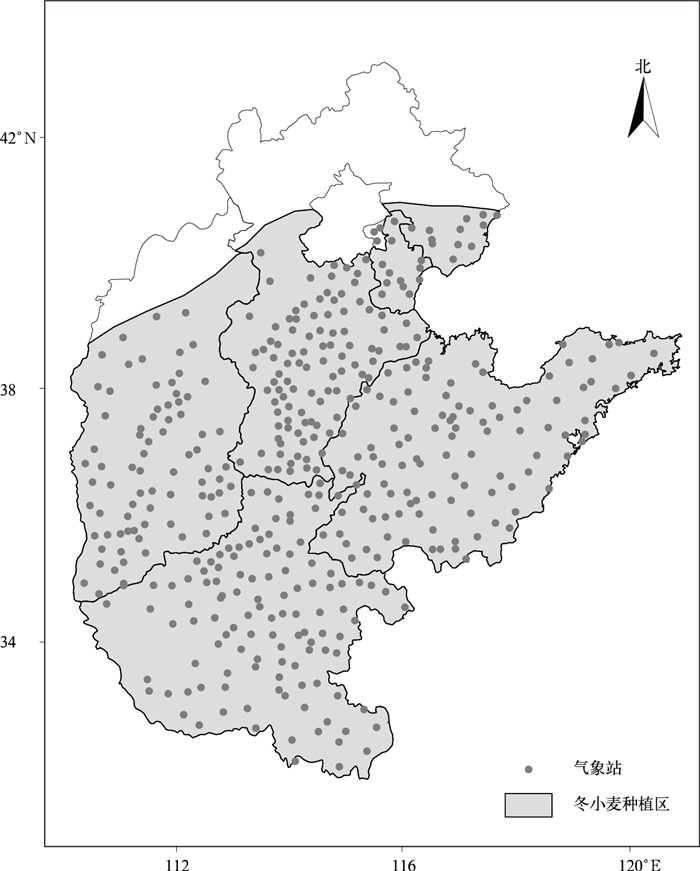
 下载:
下载:
